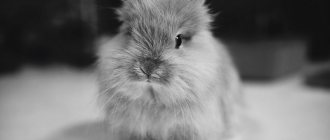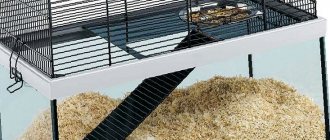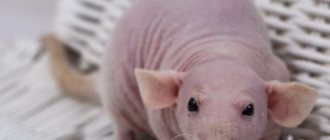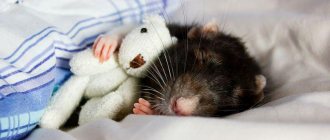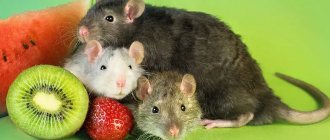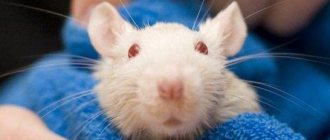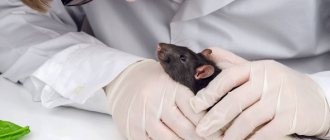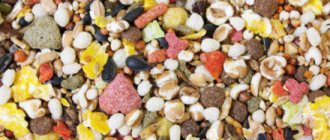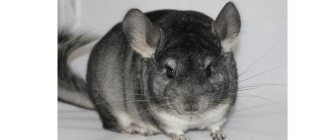Overview of varieties of decorative rats
Domestic rats differ from each other in body type and coat type. There are no breeds as such among these rodents. Among them there are varieties, each of which has a certain appearance.
A parental pair cannot be guaranteed to pass on characteristics characteristic of a variety to its offspring. For example, two rats with standard ears can give birth to a baby Dumbo rat.
Decorative rats have their own subspecies and breeds
Thoroughbred rats are divided according to certain characteristics:
- Body type (standard and dumbo);
- Coat type (standard, wavy, sphinx, rex, downy, half sphinx, velor, satin);
- Color (divided into sections: uniform, silver, ticked, marked, combined, husky, non-standard colors);
- Markings (presence and location of white on the main color);
You can buy a baby rat at a pet store or through an advertisement for a price starting from 100 rubles. A rodent from a nursery may cost more (300 – 1500 rubles), but the health guarantee is higher. In the nursery you can purchase a pet for participation in exhibitions and breeding work.
The decorative rat originated from the wild gray rat - pasyuk.
During the process of domestication, the animals changed their head shape, ear size, coat color and type, temperament and attitude towards humans. A domestic rat is the same pasyuk, only in a domesticated form.
Today there is a Standard for varieties of ornamental rats, which Russian and foreign breeders are working on.
Where is the best place to buy a rat?
When purchasing a decorative rat, future owners inevitably face the question of where is the best place to buy a pet. Experienced breeders recommend not to succumb to the temptation of purchasing an animal from your own hands at the cheapest price. It is better to pay the required amount and get a healthy rat with a good pedigree.
As a last resort, you can go shopping at a pet store. Even in the event of an unplanned pregnancy of a female, the rat pups can always be given away. But you won’t have to spend additional money on constant treatment of many diseases in expensive veterinary clinics. Moreover, most specialized stores have a good price/quality ratio.
Body type
Standard
Decorative rat of the standard breed
The animal has a proportional, flexible, plastic physique without signs of fragility. Females are somewhat lighter and look more graceful. The length of the animal is up to 26 cm (to the tip of the tail). The length of the tail is proportional to the length of the body (including the head).
The eyes are large, round and shiny. The eye color is in harmony with the coat color according to the standard. Small ears are located at the top of the head and are larger in size than the Pasyuk's ears. The head is proportional to the body, of sufficient width.
Coat type and color are determined by the general Standard.
The coat fits well and is shiny. The paws and tail are covered with short hair. Light-colored rats have short, velvety fur on their ears.
The antennae are oblong and proportionally located on the cheeks; above the eyes they are shorter and in smaller numbers. In rodents with other types of hair (rexes, sphinxes, etc.), the whiskers may be short, curled and sparse.
Dumbo
Decorative rats Dumbo
Dumbo differs from the standard in the shape of his ear and skull. Dumbo's ears are lowered and are approximately at eye level. The ear is wider and more rounded than the standard one.
The name "dambo" translates as "baby elephant". That is, the ears resemble the ear of a baby elephant.
The ear should be as open as possible. Folds are not allowed. The dumbo ear has two shapes: open and “tulip”, when the upper edge is slightly directed downwards.
The coat type and coat color correspond to the descriptions in the general Standard.
The Dumbo's skull is slightly wider than that of the standard. Due to the position of the ears, the head of this variety looks wide and flat. The back of the dumbo's head has a barely noticeable convexity.
What else do you need to buy for your rat?
Savic Freddy 2 Rodent Cage
The costs don't end with purchasing the pet itself. Before buying a rat, you need to first prepare by purchasing everything you need to keep it. Required attributes include:
- Cell. Rats are active animals, so it is better to purchase multi-tiered structures with a plastic tray. Based on 2-3 animals, the area of the first floor should be 2500-3600 cm². The distance between the twigs should be no more than 12 mm, for small rats a little less - up to 10 mm. The cost of the most modest cage that meets the listed parameters is 4-5 thousand rubles. Buying second hand will cost less - 2-2.5 thousand rubles.
- Filler. The cheapest option is shredded napkins or toilet paper. But such a filler quickly becomes dirty and does not remove unpleasant odors well, so it is better to spend money on purchasing sawdust or hay. On average, prices for filler vary from 100 to 200 rubles.
- Little house. The rat definitely needs a cozy corner for privacy. A small plastic house is perfect for this so that the fluffy doesn’t chew through it. This material is also easy to clean with warm water. The cost of such houses starts from 400 rubles.
- Hammocks. Rodents should have a place to rest, sleep or just lie down. To do this, you will need to hang 2-3 hammocks around the cage, maybe more, depending on the number of animals. The price for one product is about 350 rubles.
- Drinkers and feeders. For 2 rats you will need 2-3 pieces of each item. Depending on the model, the price for drinking bowls is 300-1000 rubles, for feeders - 200-500 rubles.
- Game complex. Rats love to frolic, so you should definitely install shells in the cage. The price range here is very wide, since today you can find many toys for rodents on sale. For example, the cost of the simplest running wheel is 150-200 rubles. At the same time, prices for balls for rodents vary between 700-1500 rubles. The bridge can be bought for 400-800 rubles, depending on the size and configuration.
- Tray. There is an opinion among rodent owners that it is impossible to toilet train rats. However, this is not so, you just need to set a goal and devote 2-3 weeks to training. The cost of a rat tray is about 200 rubles. It should be taken into account that the number of containers must correspond to the number of pets living in the cage.
- Feed. Ready-made mixtures for feeding rodents cost from 100 to 800 rubles per package. In addition, the rat will have to be supplemented with natural food - vegetables, fruits, lean meat, dairy products. Typically, all of the listed products can be found in any refrigerator, so you can not take them into account when calculating costs.
To summarize, the starting investment in keeping a rat, depending on the quality of the selected accessories, will range from 6,000 to 13,000 rubles. In addition, it is necessary to take into account that this is only the first expenditure on a pet. Because food and filler will have to be purchased constantly. And the remaining accessories can be changed as needed.
How much a pet rat costs is a controversial question. The cost of a rat and everything needed to keep it varies depending on many factors. Therefore, before going to the pet store, you will need to first calculate all the costs so as not to find yourself in an awkward situation.
Coat type
Standard
The coat is smooth, shiny, tight-fitting; the mustache is long and dense. The paws and tail are covered with fine fur. The ears have short velvet fur. The undercoat is well formed.
Curly (rex)
Curly rat (Rex)
The hair is dense, dense and forms curls. On the belly the hair is straighter. The amount of hair is less than the standard coat type, or it is absent. The hair is inferior in shine to the standard type.
Tactilely, the hair is slightly coarser than standard, without signs of brittleness or stiffness. The mustache is short and curled.
Wavy (teddy, corduroy)
Wavy Rat Corduroy Thick
, soft, even coat, more wavy than curly. Visually, the coat is slightly disheveled, but looks well-groomed. There is a thick undercoat, but the awns are practically absent. The mustache is of good length, with a slight wave.
Sphinx
Decorative rat Sphynx
The skin of the Sphynx is almost completely bald; she is healthy, bright and soft. In some areas of the body (on the muzzle, limbs and groin area) pubescence is allowed. There may be folds. The mustache is short and curly.
Downy
The body of the animal is covered with short, thin, soft fluff. On the face and lower body the hair is thicker and longer. There is no guard hair. The skin is pleasant to the touch, velvety. The antennae are slightly curled downwards. Bare areas of the body are not allowed.
Half Phinx (double rex) outside the standard
Decorative rat of the Double Rex breed.
The fur is short and harsh. The mustache is short and curls tightly. Double Rex has two types:
- The rat has hairless and hairy areas of the body. They may change over time, i.e. bare skin becomes overgrown, and pubescent skin becomes bald.
- The rodent has short hair only on the face, tail, legs and belly.
Satin (satin, longhair)
Satin Rat
The coat is thin, silky, longer than usual. The white color has a yellowish tint. The impression of “shining” wool.
Velor
There is very little or no guard hair. The coat is shorter than that of the Rex, curled or crimped. The mustache curls tightly.
Description of colors by section
Homogeneous
Black decorative rat
The hair is colored uniformly in one tone. The exception is the ash-blue color. The body has a uniform color without spots or ticking.
- Black;
- Blue (Russian blue, smoky);
- White;
- Champagne;
- Blue;
- Platinum;
- Russian silver and other solid colors.
Ticked
Agouti Rat
The body has a single color. Part of the hair is colored unevenly, in two or more colors (with belts). Among these zone-colored hairs are hairs with a uniform color.
- Agouti (platinum, Russian blue, blue);
- Faun;
- Cinnamon;
- Amber;
- Pearl (cinnamon, blue);
- Topaz.
Silver
Silver-blue rat
This section is characterized by alternating silver hair with hairs of a different color (uniform or ticked). The color is bright and uniform.
- Silver-mink;
- Silver - blue;
- Silver-black;
Combined
Siamese Dumbo Rats
The color consists of several colors (except white), which are arranged in accordance with the norms prescribed by the Standard.
- Siamese (blue, Russian blue, mink, black-eyed Siamese);
- Himalayan (blue or with black eyes);
- Burmese (Russian, wheat, sable, blue).
Marked
Decorative rat with marked color
Marking is a pattern, i.e. combination of white color with colored areas.
- Irish;
- Anglo – Irish;
- Raincoat (European, with blaze);
- Hood (or shortened hood);
- Cap (or cap with a train);
- Spotted - raincoat (or spotted);
- Train (or train with blaze);
- Masked;
Blaze is a white wedge-shaped spot on the face.
Husky (blooming)
Decorative Husky Rat
This type combines blaze (in a coat or train) with a perennial base color. Symmetry and contrast are important components for this marking. Cubs up to 3 weeks of age have a uniform color with a blaze, but later the husky's coat begins to turn silver.
- Raincoat;
- Daisy chain;
Non-standard colors
These colors are not recognized by the Rat Club.
- Dove;
- Devil;
- Black devil
An animal with these colors receives marks at the exhibition, but does not receive titles.
Odd-eyed
White rat with different eye colors.
Coat color - any. One eye is pink or red, the other is black or ruby.
Information on choosing rats, comparing the cost of different breeds
Domestic weasel - breeds, maintenance features
Depending on the breed of the animal, its cost will vary significantly. Decorative pets come in a wide variety of colors.
White rat
There is no specially bred breed of white rat. Nature created albinos; they got this color due to a genetic failure and can appear in any breed. You rarely see white rats in the wild; they are eaten by their own relatives; a rat cannot survive alone.
However, albinos are popular because of their beautiful appearance, with beautiful ruby eyes and white fur.
White rat
Note! In nature, there are no rats with pink, blue, or green shades of fur. These animals are sold by scammers. In order for the animal to acquire an unusual shade, a coloring pigment is added to its food, which changes the color of the rat. After stopping such feeding, the animal will return to its original color, but such nutrition will not be in vain for its health.
Dumbo
These representatives have large round ears. They are similar in appearance to the tiny cartoon character Dumbo the elephant. Pets of this breed have a lively and perky character, are attached to the owner and are flexible. Their fur can be gray, black, white or spotted.
Dumbo
Blue
Blue rodents are actually light gray in color. Their fur appears blue due to the bluish undercoat. This breed, with such a shade, is considered aristocratic and highly valued.
Blue Rat
Rex
These rodents have tousled fur that sticks out in different directions and creates the appearance of fluffiness. Grown-up individuals have small curls of fur on their backs.
Note! Baby Rex is not born with curls. He changes fur color weekly.
Rex
Sphinxes
Animals without hair are the rarest and are more valuable than other breeds. Purebred individuals have a little fluff on the ankles, in the groin area and under the eyes. The skin can be different, even spotted.
Sphinx
Anurans
It is considered the rarest breed. The body shape of this rat is similar to a pear. There is a small bump where the animal should have a tail. Scammers often sell animals with docked tails. It is recommended to buy this breed only from a trusted breeder. The color of tailless animals may be different. The fur can be curly, short, long, or the rat can be bald.
Tailless rat
Odd-eyed
This breed is considered the most expensive. The eyes of these animals can be: black, dark ruby and red. The cost of the animal depends on the external difference between the eyes. Multi-colored eyes in rats can appear in any breed.
Odd-eyed
Other varieties
Pasyuk
This is a fairly large rodent, weighing 250-600 grams. Unlike the domesticated form, the pasyuk has a convex forehead and well-defined brow ridges. The pasyuk's tail is thick and its length is shorter than the body. The ears are relatively small. Pasyuk is a homogeneous standard agouti.
Rat Pasyuk
Pasyukov can be kept at home, including together with a domesticated rat. Some nurseries infuse the blood of wild gray rats into domestic animals or breed only pasyuki.
Pasyuk retained most of his natural instincts. He easily accepts new experiences, thinks quickly and survives in the wild.
Tailless rat (Manx)
Manx is the result of a complex mutation. Many unions of rat lovers are against the breeding of this species. Accordingly, it is unrecognized. Tailless Manx are disabled by definition, as they have lost their balance beam. In addition, the tail cools the animal at high temperatures.
As a result of this mutation, the musculoskeletal system and organs of the excretory system are affected. Often the cubs die at an early age or a little later.
All varieties are kept under the same conditions. The features of caring for each rat are also the same. Animals are kept in spacious cages and terrariums, in a warm and dry place, without drafts. The rats are provided with quality food and water, a running wheel and toys.
Based on the description of the species, rodents are given a specific name. For example, Albino Self Standard Velveteen means that the rat is a standard albino with a solid color and corduroy coat type. BE Siamese Self Dumbo Rex – Dumbo with black eyes, Siamese color with curly coat type.


